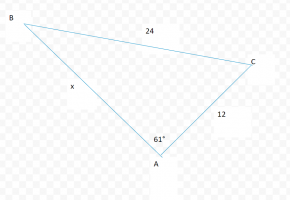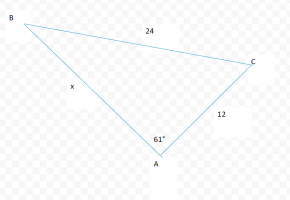You are using an out of date browser. It may not display this or other websites correctly.
You should upgrade or use an alternative browser.
You should upgrade or use an alternative browser.
Cosine law with quadratic equation
- Thread starter bed
- Start date
D
Deleted member 4993
Guest
Do you know the laws of cosines for a planar triangle?Hi, I need some help with this question. I have to solve for x using the cosine law. Thank you!
View attachment 33498
Please show us what you have tried and exactly where you are stuck.
Please follow the rules of posting in this forum, as enunciated at:
Please share your work/thoughts about this problem

Otis
Elite Member
- Joined
- Apr 22, 2015
- Messages
- 4,414
Hi bed. Here's a link to a web page that explains the Law of Cosines and shows worked examples of how to use it. Your exercise may be solved the same way. Please share how far you can get, or tell us which part(s) you're unsure about, and we can go from there.
Be sure to note the section with the blue subheading: "Versions for a, b and c". You've been given the measurement for angle A only; you need to use the form containing cos(A).
 EDIT: There seems to be an issue with the triangle as labeled. I'd found a solution using those measurements but was unable to confirm it, so that triangle might not exist. I was able to confirm a different solution, after changing 61º to 64º. (If we use 61º, then I think one of the given side measurements might need to change.)
EDIT: There seems to be an issue with the triangle as labeled. I'd found a solution using those measurements but was unable to confirm it, so that triangle might not exist. I was able to confirm a different solution, after changing 61º to 64º. (If we use 61º, then I think one of the given side measurements might need to change.)
[imath]\;[/imath]
The Law of Cosines
www.mathsisfun.com
Be sure to note the section with the blue subheading: "Versions for a, b and c". You've been given the measurement for angle A only; you need to use the form containing cos(A).
[imath]\;[/imath]
Otis
Elite Member
- Joined
- Apr 22, 2015
- Messages
- 4,414
I don't know what happend to the OP. Here's one method.
Law of Cosines (using the known angle):
a^2 = b^2 + c^2 - 2∙b∙c∙cos(A)
where a=24, b=12 and A=61º
576 = 144 + c^2 - 2(12)(c)(0.8746)
c^2 - 11.6354∙c - 432 = 0
Solve for positive c, using the Quadratic Formula:
c = 27.4012
My issue before involved confirmation using sin(A)/a=sin(C)/c, to find C and then B. That did not work.
I was able to confirm c=27.4012, using sin(A)/a=sin(B)/b, to find B first and then C.
(I ought to have tried that alternate approach, before wrongly concluding a measurement issue.)

[imath]\;[/imath]
Law of Cosines (using the known angle):
a^2 = b^2 + c^2 - 2∙b∙c∙cos(A)
where a=24, b=12 and A=61º
576 = 144 + c^2 - 2(12)(c)(0.8746)
c^2 - 11.6354∙c - 432 = 0
Solve for positive c, using the Quadratic Formula:
c = 27.4012
My issue before involved confirmation using sin(A)/a=sin(C)/c, to find C and then B. That did not work.
I was able to confirm c=27.4012, using sin(A)/a=sin(B)/b, to find B first and then C.
(I ought to have tried that alternate approach, before wrongly concluding a measurement issue.)
[imath]\;[/imath]
Steven G
Elite Member
- Joined
- Dec 30, 2014
- Messages
- 14,383
Sitting in a dark corner usually cools down the brain.I asked someone to check using the given measurements, and they confirmed their solution (which matches my original solution). I need to go back to the drawing board (after my brain cools down).
[imath]\;[/imath]
Steven G
Elite Member
- Joined
- Dec 30, 2014
- Messages
- 14,383
I too thought to use the law of sines 1st to avoid a quadratic equation. Why would the law of sines fail?My issue before involved confirmation using sin(A)/a=sin(C)/c, to find C and then B. That did not work.
I was able to confirm c=27.4012, using sin(A)/a=sin(B)/b, to find B first and then C.
(I ought to have tried that alternate approach, before wrongly concluding a measurement issue.)
[imath]\;[/imath]
Dr.Peterson
Elite Member
- Joined
- Nov 12, 2017
- Messages
- 16,093
It doesn't (though in principle, like the quadratic, it could have produced two solutions, and it's easier to forget that). But presumably the OP was told to use the law of cosines:I too thought to use the law of sines 1st to avoid a quadratic equation. Why would the law of sines fail?
Hi, I need some help with this question. I have to solve for x using the cosine law. Thank you!
View attachment 33498
Otis
Elite Member
- Joined
- Apr 22, 2015
- Messages
- 4,414
Oops, Steven. I hadn't meant to imply that. My effort to confirm the triangle usingWhy would the law of sines fail?
sin(A)/a = sin(B)/b = sin(C)/c
did not work because I'd failed to consider the possibility that angle B or C might be obtuse. (I wish I could blame the op diagram for that, but I've been fooled by disproportionate diagrams before, so I ought to have known better. More likely, it was complacency on my part.)
Finding B first leads to C = 93.0676º (correct, obtuse angle)
But I'd solved for C first, getting arcsin(0.9985) = 86.9084º (incorrect), failing to consider a potential last step:
C = 180º - 86.9084º = 93.0676º
By the way, I've already spent my time in the corner for that goof, so don't even thinkaboutit!
?
Dr.Peterson
Elite Member
- Joined
- Nov 12, 2017
- Messages
- 16,093
Interestingly, that's exactly what I had in mind when I wroteBut I'd solved for C first, getting arcsin(0.9985) = 86.9084º (incorrect), failing to consider a potential last step:
C = 180º - 86.9084º = 93.0676º
I usually recommend using sines for a triangle like this (SSA), but the cosine approach does have this in its favor.It doesn't (though in principle, like the quadratic, it could have produced two solutions, and it's easier to forget that).
I think that particular corner is well-populated ...

